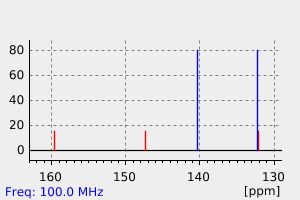4-亚硝基-5-苯基-1H-咪唑 | 106232-36-4
中文名称
4-亚硝基-5-苯基-1H-咪唑
中文别名
——
英文名称
4(5)-nitroso-5(4)-phenylimidazole
英文别名
4-Nitroso-5-phenylimidazole;4-nitroso-5-phenyl-1H-imidazole
CAS
106232-36-4
化学式
C9H7N3O
mdl
——
分子量
173.174
InChiKey
LFIVWAMAAWKOGO-UHFFFAOYSA-N
BEILSTEIN
——
EINECS
——
-
物化性质
-
计算性质
-
ADMET
-
安全信息
-
SDS
-
制备方法与用途
-
上下游信息
-
文献信息
-
表征谱图
-
同类化合物
-
相关功能分类
-
相关结构分类
计算性质
-
辛醇/水分配系数(LogP):1.4
-
重原子数:13
-
可旋转键数:1
-
环数:2.0
-
sp3杂化的碳原子比例:0.0
-
拓扑面积:58.1
-
氢给体数:1
-
氢受体数:3
SDS
上下游信息
-
上游原料
中文名称 英文名称 CAS号 化学式 分子量 4-苯基咪唑 4-Phenylimidazole 670-95-1 C9H8N2 144.176 -
下游产品
中文名称 英文名称 CAS号 化学式 分子量 —— 5-Phenyl-3H-imidazol-4-ylamine 111328-06-4 C9H9N3 159.191 1-甲基-5-亚硝基-4-苯基-1H-咪唑 1-Methyl-5-nitroso-4-phenylimidazole 111380-08-6 C10H9N3O 187.201 —— 1-methyl-4-nitroso-5-phenylimidazole 111380-09-7 C10H9N3O 187.201 1-甲基-5-硝基-4-苯基咪唑 1-methyl-4-phenyl-5-nitroimidazole 14953-63-0 C10H9N3O2 203.2
反应信息
-
作为反应物:描述:参考文献:名称:Cusmano; Ruccia, Gazzetta Chimica Italiana, 1958, vol. 88, p. 463,480摘要:DOI:
-
作为产物:描述:参考文献:名称:Acid-catalyzed decomposition of 4(5)-nitroso-5(4)-phenylimidazole in methanol and water摘要:DOI:10.1021/jo00383a040
文献信息
-
Nitrosoimidazoles: highly bactericidal analogs of 5-nitroimidazole drugs作者:William J. Ehlhardt、Bernard B. Beaulieu、Peter GoldmanDOI:10.1021/jm00397a009日期:1988.2relative biological activity of 4- and 5-nitroimidazoles examined previously. In contrast, all three nitroso compounds are considerably more bactericidal than their analogous nitro compounds under both aerobic and anaerobic conditions, a finding that provides direct evidence that reduction of the nitro group is responsible for activation of the nitroimidazoles. Further evidence is also consistent with据信甲硝唑和相关的5-硝基咪唑通过硝基的还原而被活化,并且活性物质具有中等氧化态的氮官能度。然而,已证明难以治疗性地制备和分离5-硝基咪唑的活性形式。为了解决这个问题,我们从4(5)-nitroso-5(4)-制备了1-methyl-4-phenyl-5-nitrosoimidazole(3)和1-methyl-4-nitroso-5-phenylimidazole(5)-苯基咪唑(1)。我们还制备了同源的硝基咪唑。发现DNA修复缺陷的大肠杆菌突变体对1-甲基-4-苯基-5-硝基咪唑(4)和甲硝唑均敏感,但对1-甲基-4-硝基-5-苯基咪唑(6)具有相当的抵抗力。 ,与先前研究的4-和5-硝基咪唑的相对生物学活性相符的发现。相反,在需氧和厌氧条件下,所有三种亚硝基化合物均比其类似的硝基化合物具有更大的杀菌作用,这一发现提供了直接的证据,即硝基的还原是硝基咪唑活化的原因。尽管更保守的解释是简
-
Antitumor imidazotetrazines. 14. Synthesis and antitumor activity of 6- and 8-substituted imidazo[5,1-d]-1,2,3,5-tetrazinones and 8-substituted pyrazolo[5,1-d]-1,2,3,5-tetrazinones作者:Edward Lunt、Christopher G. Newton、Christopher Smith、Graham P. Stevens、Malcolm F. G. Stevens、Colin G. Straw、Roger J. A. Walsh、Peter J. Warren、Christian FizamesDOI:10.1021/jm00385a018日期:1987.2The systematic variation of the potent antitumor agent mitozolomide (1) is extended to cover alteration of substituents at positions 6 and 8 and to change the imidazo[5,1-d]-1,2,3,5-tetrazinone (1) skeleton to the isomeric pyrazolo-[5,1-d]-1,2,3,5-tetrazinone (17) skeleton. The series of eight 6-alkyl and 6-aralkyl derivatives of 1 showed optimal antitumor activity when the group was small or linear, but activity diminished as size and branching of this substituent increased. This may reflect altered transport characteristics, or failure of the enlarged derivatives to fit a binding site, or possibly a reduced tendency for the derivatives having bulky groups at position 6 to hydrolytically generate the putatively active triazenes (21). Testing of 14 derivatives of 1 differently substituted at position 8 revealed a complex structure-activity relationship, with good antitumor activity obtained for carbamoyl and sulfamoyl groups bearing small substituents. The 8-methylsulfonyl compound had noteworthy activity, but the 8-cyano, 8-nitro, and 8-phenyl derivatives were devoid of useful antitumor activity in these tests. From the limited number of pyrazolotetrazinones (17) reported here, it is suggested that the same conclusions as regards activity also hold true for this ring system.
-
Cusmano; Didonna, Gazzetta Chimica Italiana, 1955, vol. 85, p. 208,215作者:Cusmano、DidonnaDOI:——日期:——
-
Ruccia,M.; Natale,G., Gazzetta Chimica Italiana, 1960, vol. 90, p. 1047 - 1055作者:Ruccia,M.、Natale,G.DOI:——日期:——
-
Radical anions of nitrosoimidazoles: Putative intermediates in the mechanism of action of nitroimidazole antibiotics作者:Martyn C.R. Symons、W. Russell Bowman、Peter F. TaylorDOI:10.1016/s0040-4039(00)94737-3日期:1990.1
表征谱图
-
氢谱1HNMR
-
质谱MS
-
碳谱13CNMR
-
红外IR
-
拉曼Raman
-
峰位数据
-
峰位匹配
-
表征信息
同类化合物
(SP-4-1)-二氯双(1-苯基-1H-咪唑-κN3)-钯
(5aS,6R,9S,9aR)-5a,6,7,8,9,9a-六氢-6,11,11-三甲基-2-(2,3,4,5,6-五氟苯基)-6,9-甲基-4H-[1,2,4]三唑[3,4-c][1,4]苯并恶嗪四氟硼酸酯
(5-氨基-1,3,4-噻二唑-2-基)甲醇
齐墩果-2,12-二烯[2,3-d]异恶唑-28-酸
黄曲霉毒素H1
高效液相卡套柱
非昔硝唑
非布索坦杂质Z19
非布索坦杂质T
非布索坦杂质K
非布索坦杂质E
非布索坦杂质D
非布索坦杂质67
非布索坦杂质65
非布索坦杂质64
非布索坦杂质61
非布索坦代谢物67M-4
非布索坦代谢物67M-2
非布索坦代谢物 67M-1
非布索坦-D9
非布索坦
非唑拉明
雷非那酮-d7
雷西那德杂质2
雷西纳德杂质L
雷西纳德杂质H
雷西纳德杂质B
雷西纳德
雷西奈德杂质
阿西司特
阿莫奈韦
阿考替胺杂质9
阿米苯唑
阿米特罗13C2,15N2
阿瑞匹坦杂质
阿格列扎
阿扎司特
阿尔吡登
阿塔鲁伦中间体
阿培利司N-1
阿哌沙班杂质26
阿哌沙班杂质15
阿可替尼
阿作莫兰
阿佐塞米
镁(2+)(Z)-4'-羟基-3'-甲氧基肉桂酸酯
锌1,2-二甲基咪唑二氯化物
锌(II)(苯甲醇)(四苯基卟啉)
锌(II)(正丁醇)(四苯基卟啉)
锌(II)(异丁醇)(四苯基卟啉)







